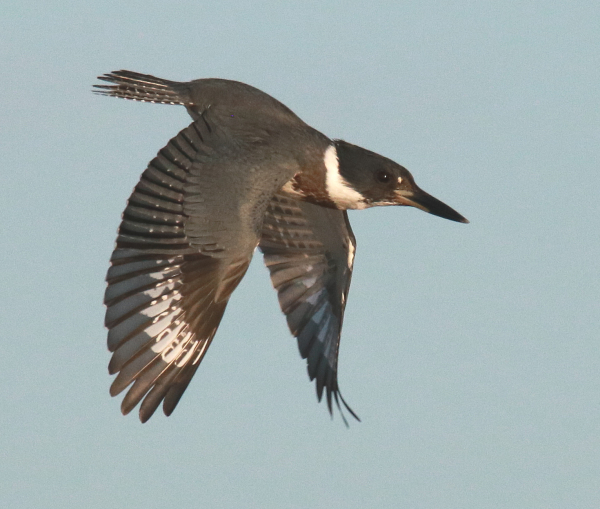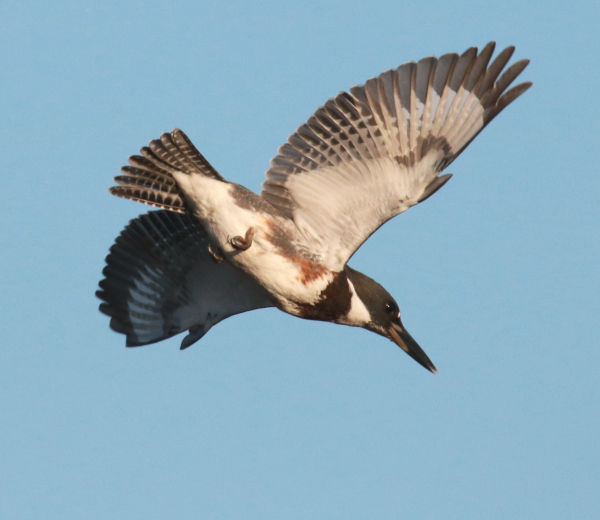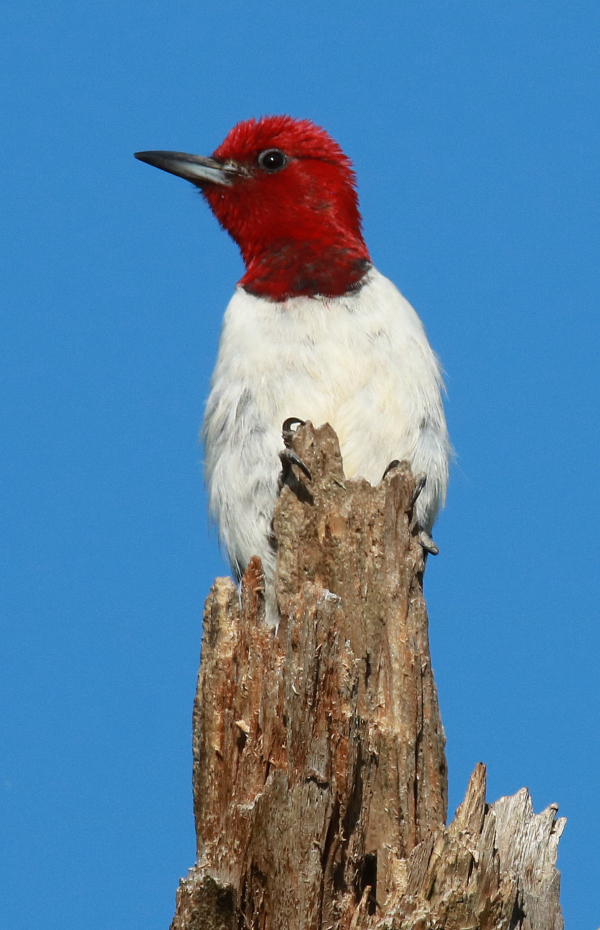
Another opportunity to photograph the grace and speed of the young Belted Kingfisher in flight was part of the thrill of observing and photographing at a tranquil prairie marsh.


A different head-on angle on the Red-headed Woodpecker that Paul photographed Sunday. You can see other interesting photos taken during that photo session in the Bird Photography article in this issue.
|
I enjoyed a fine mix of bird sightings last Wednesday during a late-afternoon birding drive, featuring a surprise appearance of the first Loggerhead Shrike of the year that I’ve seen in the area, along with the first fledgling Northern Harrier of the season. Actually, I saw several other harriers, including 3 males and 2 females, along with 2 groups of Northern Flickers numbering up to 3, a Least Flycatcher, Common Nighthawks, an American Bittern that provided some sunset photos; and to top it off, a Great Horned Owl hooted a couple times from some nearby trees.
Almost daily I see an adult Bald Eagle, but not the same one, as indicated by the miles between sightings. As the week continued, I enjoyed multiple sightings of a stunning adult perched on the highest rock atop the tallest hill in the area. The mega-hill offers a remarkable view of a huge shallow wetland to the northwest and an even larger lake to the east, both surrounded by an expanse of native prairie and hills – good hunting territory. Eagle sightings are not unexpected at this time of the year, but eagles will become an ever-larger part of the raptor fauna through November.
During my drive to Bismarck Thursday afternoon, Red-tailed Hawks were scattered across the plains as they approach peak migration numbers. Raptor numbers were augmented by several Swainson’s Hawks, Northern Harriers, and the prize of the day – a sleek Prairie Falcon that took flight across a vast prairie area about 30 miles northwest of my office. I didn’t get a great look at the falcon, but I was able to follow it for almost a mile before loosing sight of the arrow-shaped hunter in the distance.
Woodpecker Update
Friday, by the time clouds revealed the evening sun, I focused myself on the pair of Red-headed Woodpeckers about 4 miles south of my office, and the hour-long period observing these birds was really enjoyable, partly due to the birds, and partly due to the serenity of the evening with the slightest breeze that stoked the freshest air with a hint of sweetness after 1½ inches of rain the previous day. The rain also washed the dust off the plants and other landscape features that made the light seem brighter and the colors richer.
The 2 adult Red-heads were actively hunting large insects on the ground, mostly from elevated perches, usually bare branches or snags. But they also watched for flying insects, which they made aerial flights to catch in mid-air – “hawking insects” is the term usually used for this style of hunting. After each catch, the adult would dispatch the grasshopper, cricket, or another big bug, then carry it to the nesting cavity to feed their nestlings.
A big surprise was to see one of the adults flying high overhead within a circling flock of about 15 swallows – Tree and Barn Swallows – which suggested it was after smaller flying insects. For the second time I also observed the woodpeckers flying down to a mud puddle to drink. The first time I noticed this behavior, I was unsure if they were drinking or catching insects at the water’s edge; but Friday it was obvious the birds were drinking.
At an opportune time, I also repositioned to a location where I could get a better look at the nesting cavity entrance to see if the nestlings were big enough to crawl up to the opening when an adult approached. In just moments my question was answered when an adult arrived and reached its head inside to feed the nestlings. As noted a couple weeks ago, I am hoping to get a photo of an adult feeding a nestling or 2 reaching out of the cavity entrance, which should happen in advance of fledging.
Gosh, it seems late for the woodpeckers to still have nestlings, but maybe this is a second nesting attempt. Realistically, I’m just glad to be able to monitor the action and behaviors relatively easily – with a few excellent opportunities to photograph these beautiful woodpeckers regularly.
Saturday Sightings
After another overnight rain, a cloudy sky made it a birding day without the weight of a camera and lens. The fun began with a surprise appearance of 2 young Red-eyed Vireos in the sumacs and ash tree adjacent to my feeding station, obvious migrants that may have been short-stopped by the rain. I also heard a Gray Catbird in my backyard, hidden behind the chokecherry bramble. Then too, there were still at least 3 female or immature Ruby-throated Hummingbirds keeping my feeding station active. I decided to do a little exploring to the north for a change in the absence of sunshine, and was pleasantly surprised to see a recently fledged Swainson’s Hawk about 8 miles north with many Red-tails along the way, along with a couple adult Swainson’s, including a rufous morph.
About 11 miles north, I was encouraged to stop by the sight of a concentration of shorebirds on an expansive very shallow marsh. What really caught my eye was a large scattered flock of American Avocets that easily numbered more than 60. I haven’t seen avocets for some weeks, indicating the local nesters had dispersed, and I’m thinking these birds came from other areas. Among the avocets were Long-billed Dowitchers, Lesser and Greater Yellowlegs, Pectoral Sandpipers, and smaller sandpipers that I couldn’t identify with certainty from afar in poor light.
It was nice to see this mixed group of shorebirds, which have become uncommon during the past couple weeks. The last bird of note I spied before heading back to the office was a young Krider’s Red-tailed Hawk, a beautifully marked bird with an abundance of white on its back, as well as a pure white head and underside. Now that would have been a nice bird to photograph! On my way back I passed a familiar grove of old flooded cottonwood trees on the edge of a deep lake that provide a popular roost site for Double-crested Cormorants, with almost 100 assembled ahead of sunset.
Sunday Fun
After spending time watching one of the adult Red-headed Woodpeckers nap in 2 different positions - lying atop a branch, then hanging from it nuthatch-style, after a big cloud passed the woodpecker seemed to rejuvenate and spring into action stretching forward, calling, bowing forward and teetering upright – it was quite an extended display over a few minutes, and I managed some personally favorite photos in the process (see the Bird Photography feature in this issue and a single image here).
After spending about 45 minutes with the Red-head, I continued south, then east. Along the way I crossed paths with a vocal adult Swainson’s Hawk and a beautiful recent fledgling. I could also see a second fledgling and another adult about a quarter-mile away in the same hayfield. Like the Ferruginous Hawks I monitored in July, these Swainson’s were hunting the short-cut grassland that provided open views of resident ground squirrels, pocket gophers, mice, and meadow voles. It’s a great place for fledglings to learn to hunt and ever-improve their flying skills, and in addition to the small mammals, they Swainson’s tend to catch garter snakes, and large grasshoppers at this time of year. They will begin their mega-migration south to the grasslands of Argentina at the end of September.
The Red-headed Woodpecker wasn’t my only long-term photo subject Sunday; on the edge of a little bay of a larger lake I found another Belted Kingfisher – or was it the same one? After an initial impression that this was a female, it turned out to be a young kingfisher, undoubtedly the same one I photographed 8 days earlier about half a mile to the north. I appreciated that the kingfisher permitted me to approach a little closer than before, and had my best chances of photographing it as it began dives toward water-based prey and when it returned to its wire perch. It was another one of those beautiful late August evenings, windless with a perfect temperature and clear blue sky on the edge of a glassy lake bordered by a seemingly endless grand prairie.
Between the woodpecker and the kingfisher, there was a scattering of Red-tailed Hawks, another recently fledged Northern Harrier, a family group of 3 Northern Flickers, 3 Sharp-tailed Grouse in flight, a flock of about 50 post-nesting Franklin’s Gulls, an abundance of molting ducks, mostly Mallards, Blue-winged Teal, and Ruddy Ducks it seems, along with growing flocks of Giant Canada Geese that assemble each morning and evening in harvested wheat fields. A couple Snowy Egrets, a few groups of Great Egrets rounded out my mental bird list, and it was a welcome sight to see a flock of 5 Great Egrets flying in graceful formation overhead with the sun setting as I approached home after another glorious evening birding drive.
Orange Flash
Last Friday, just as I was about to give up on the oriole feeder, a flash of orange brought me back to the reality of early fall migration in the region. It’s been way too long since my last oriole sighting, but the seeing of a bright orange “yearling?” Baltimore Oriole really elevated my excitement level as I began work on this week’s issue of The Birding Wire. Certainly that’s what makes birding so much fun – a flash can bring unexpected, exciting surprises into view – and they can disappear just as quick, but the ones that remain in view, and those that return time and time again provide a level of fun that adds to the searches we tend to conduct, at home and as we visit favorite birding locations. Enjoy this new month of September with gusto and a wealth of great birding experiences!
Article and photos by Paul Konrad
Share your bird sightings and photographs at editorstbw2@gmail.com